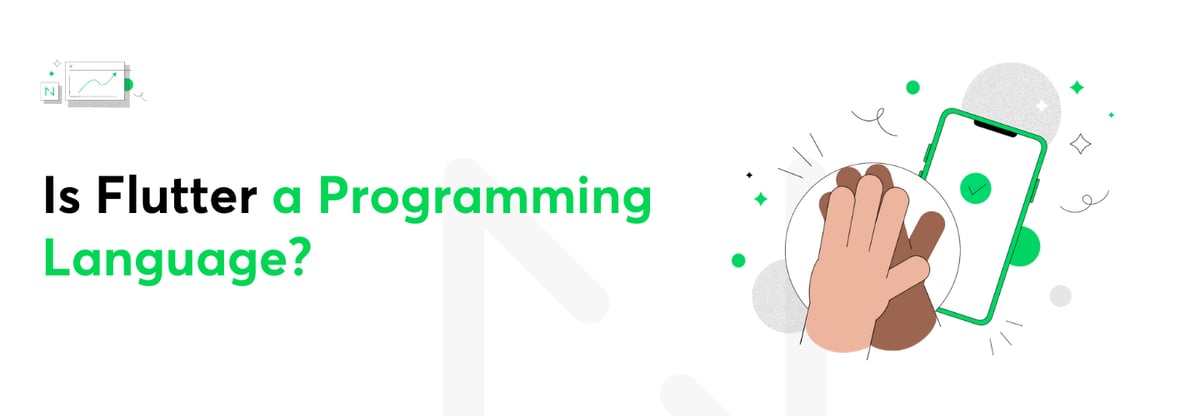Is Flutter a Programming Language?

What is Flutter?
Flutter is an open-source framework used to build native-looking iOS and Android apps from a single codebase. It was created by Google in 2015 and since then has been used to develop over 100,000 apps.
There are a number of good reasons for Flutter’s popularity. Flutter can be used to quickly and easily develop apps for different operating systems while achieving native performance and visual consistency on different platforms. It also includes a hot reload feature, which automatically updates UI content when the code changes, allowing for smoother coding.
Is Flutter a programming language?

However, Flutter is not a programming language. It’s a software development kit (SDK) with prewritten code, consisting of ready-to-use and customizable widgets, as well as libraries, tools, and documentation that together serve to build cross-platform apps. Flutter’s language for cross-platform development is Dart, which was also developed by Google.
Flutter avoids using a bridge to communicate with the native layer (such as Android or iOS). This minimizes performance issues and boosts app startup time.
Of course, Flutter having its own programming language means that to get your app developed, you’ll need developers to code in Dart. However, Dart is quite similar to Java, .Net, Kotlin, Swift or JavaScript and it’s relatively easy to learn.
So is Flutter worth bothering with? What benefits will it bring for your product and what are the specifics of Flutter as an SDK and its programming language?
What is an SDK - examples of software development kits for mobile apps
An SDK is a ready-to-install package of software development tools that facilitate creating an app. There are two types of SDKs - native and cross-platform. Native SDKs are specific to each platform, meaning if you use Google’s Android SDK to develop an Android app, you’d need to start over again to create the same app for Apple’s iOS - and vice versa.
However, there are also SDKs that offer cross-platform development. Flutter is one of them. Some of the other popular options are:
- React Native - developed by Facebook and open-source, it uses JavaScript as its programming language to build apps, but also allows you to write modules in other languages, including C, Java, and Swift.
- Xamarin - created by Microsoft and works on Android, iOS and Windows. Microsoft claims that it allows developers to share an average of 90% of their application across platforms.
- Ionic - uses languages such as CSS and JavaScript to develop apps.
What is Dart and how it works with Flutter

As per Google, Flutter’s language, Dart “is a client-optimized language for fast apps on any platform”. It’s object-oriented, like Java, C++ and Python, to name just a few. It compiles ahead of time to native ARM or x64 machine code (and to JavaScript bytecode for web). That makes an app written in Dart impossible to distinguish from a native app at the machine level.
Dart has uses beyond Flutter, as well: Google engineers deploy it for some apps, like Google Ads, both for web and mobile. So it’s clear Google is invested in the language and for now it seems like it will keep investing in its development in the future. That should be an important factor if you’re looking at whether you’re developing your software product using technology that will continue to grow and not stagnate.
Yet, Dart is still not a very popular language - it’s always around the 20th position on the Popularity of Programming Languages list and #32 on the TIOBE Index. Looking for developers experienced in Dart might be a struggle, but the ones proficient in languages with C-like syntax should be able to quickly grasp it.
What else you should know about Flutter
There are a few other specific features of Flutter that might influence your decision on whether to make it your SDK of choice.
Flutter is built entirely on widgets
It takes time to get used to an environment where everything, including fonts, styles or scrolling is a widget. Once you get the grasp of it though, there’s a logic to it.
Flutter for web and Fuchsia
Besides building mobile apps with Flutter, it’s also possible to build web applications with this SDK, although this functionality is still in beta. It supports standard web technologies such as JavaScript, CSS, and HTML. However, for now Flutter is not ideal for everything. For example, it won’t work amazingly on text-rich websites like blogs. Desktop support for Flutter is also being developed but for now it’s still in the alpha stage.
That’s not all: Flutter will also be the default toolkit for building apps for Fuchsia OS, officially “one of Google’s experiments around new concepts for operating systems”, or, as some suspect, the company’s effort to replace Android. All apps in Fuchsia will be written using the Flutter SDK. This would give Flutter an amazing boost in the future.
Flutter’s growing community
Although Flutter and Dart are not that popular yet, the number of Flutter developers is steadily growing and they’ve already created one of the best and most helpful communities. The resources and documentation available are of the highest quality. You can find them via GitHub, Slack, and other platforms.
Is Flutter right for you?
With Google putting a lot of resources behind Flutter, there’s no doubt that this SDK will be gaining speed in the tech community. Whether or not you should follow the hype is a different issue: there’s no one-size-fits-all solution and Flutter is not for everyone.
At Netguru, we help everybody from startups to the biggest enterprises develop mobile software products that fit their needs. If you’re excited about the Flutter SDK or its language, but are not sure you have enough experience, reach out to us. We’ve created apps in Flutter and will help you decide on the best road toward an amazing software product.


